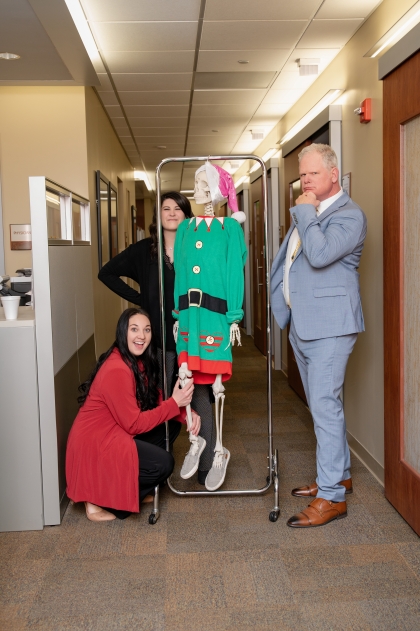October - Bone and Joint Month

By Dr. Richard Lawton, Community Hospital Orthopedic Surgeon
Happy Bone and Joint month! I suspect you are probably not celebrating Bone and Joint Month with festive parties, cake, and games, but at least being aware of it permits us to discuss important elements of optimizing our joint health.
The human body has 206 bones, and we have learned that they are living tissues that change and respond to our activities, age, and medical conditions. The humerus (upper arm bone) of a professional baseball pitcher is 3 times stronger than the bone in their non-throwing arm. Crazy! Astronauts in weightless space return to earth with severely brittle bones, which return to normal density after resuming weightbearing activities on earth. Your bones have a blood supply and respond to what you are doing. You can affect your bone health, which is important to decrease your risk of fracture, or breaking those bones.
The human body has 360 joints, which are points where bones meet. A typical joint includes the ends of the bones, the cartilage cap cushioning those bones, and the other surrounding structures, like the ligaments that help maintain alignment and provide stability. While most joints follow this structure, some, like the knee, have unique features such as extra padding, better known as the meniscus.
Healthy joints are important because they permit us to function. We tend to take our joints for granted, but if you are able to stand, walk, lift and do other things, you can thank your joints for the privilege. If they don’t hurt, why would we ever think about them? Unhealthy joints generate pain or instability, which makes getting around and moving unpleasant. If you want to move well in life, whether through walking, working, running, or participating in sports, you will be more effective if your joints are in good health. It should be a priority for all of us.
Possessing healthy joints is part luck, part prevention. Let’s start with the luck part. Genetics determine, to some degree, the durability of our joints. Some people seem to have incredibly durable cartilage, which permits pain-free weight bearing and motion. People with good cartilage genetically are much less likely to experience deterioration of that cartilage over the course of their life and correspondingly have a leg up (pun intended) for avoiding joint problems like arthritis. However, others, with genetically inferior cartilage, experience wear-and-tear erosion and loss of cartilage relatively early in life, which is what osteoarthritis is. Their joints become painful because they have bone rubbing on bone, which generates pain and inflammation limiting their ability to function, which correspondingly requires treatment.
Avoiding injury is also important. Injuries such as fractures of bone into the joint or tearing tissue within the joint can sometimes have long term effects on joint health. Fractures usually occur with trauma, such as car wrecks or falls off ladders. Among the more common non-bony joint injuries are tears of the ACL, a big ligament in the knee, or the meniscus pads in the knee. Injuries to these joints often increase the risk of developing arthritis later in life, and are more likely to occur in certain activities, such as football, basketball, skiing and soccer, though farmers and ranchers see their fair share as well. Sorting cattle is a cutting and pivoting contact sport for sure! These injuries are part luck but also partly related to activities the people choose to do.
Other prevention efforts include healthy lifestyle and diet. Staying active with weightbearing activities such as walking, and adding resistance exercises, such as light weightlifting, improve bone health and decrease the risk of osteoporosis and related bone fractures. Your health care provider and physical therapist can inform you about options.
Maintaining a healthy diet is essential for joint health. Avoiding highly processed foods, and focusing on consuming protein, fruits, and vegetables is key. Especially important is maintaining a healthy weight, as excess weight puts more stress on your joints than they are designed to handle. Think of this like putting the weight of a Ford F250 on the tires of a Ford Escort – it’s too much. Our cartilage has limits, and the added pressure from obesity can start to break down, resulting in arthritis. Additionally, the treatment of arthritic joints in obese patients has higher complication rates, worsening outcomes. Simply put, keeping a healthy weight protects your joints.
Regarding supplements, science is a bit weaker. There’s not much to suggest that taking certain supplements will improve joint health, build cartilage, or repair injured tissue. Exceptions can include calcium supplements, especially for those not able to get calcium in through their diet, or those with mild bone density problems (osteopenia). Other substances such as arnica, turmeric, garlic, chondroitin sulfate and the like can help some patients feel a bit better but have not been shown to improve joint health. If you have additional questions, please make sure you access reliable sources, such as your primary care provider.
Celebrate your healthy joints by recognizing the importance of joint wellness and staying proactive about maintaining it. Being aware of the steps you can take—such as regular exercise, proper nutrition, and injury prevention—can help you keep your joints strong and flexible for years to come.
